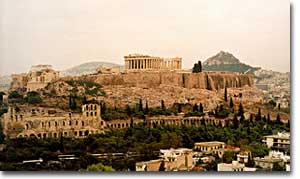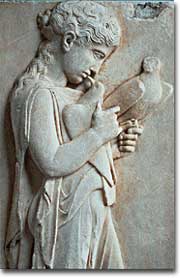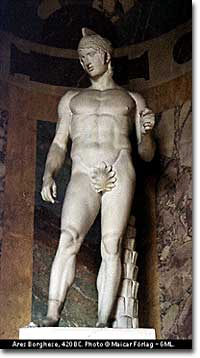What Was the Art and Culture in Athens and Sparta

5a. Rise of City-States: Athens and Sparta

The Acropolis played an integral function in Athenian life. This hilltop not only housed the famous Parthenon, but it likewise included temples, theaters, and other public buildings that enhanced Athenian culture.
Geography plays a critical part in shaping civilizations, and this is particularly truthful of ancient Greece.
The Greek peninsula has ii distinctive geographic features that influenced the evolution of Greek order. First, Greece has easy access to water. The land contains countless scattered islands, deep harbors, and a network of modest rivers. This easy access to water meant that the Greek people might naturally get explorers and traders.
Second, Greece's mountainous terrain led to the development of the polis (city-land), kickoff virtually 750 B.C.E. The high mountains made information technology very difficult for people to travel or communicate. Therefore, each polis developed independently and, often, very differently from 1 another. Eventually, the polis became the structure by which people organized themselves. Athens and Sparta are two good examples of metropolis-states that assorted greatly with each other.
Athens: The Think Tank

Life was non like shooting fish in a barrel for Athenian women. They did not savor the same rights or privileges as males, being nearly as depression equally slaves in the social system.
The city-state of Athens was the birthplace of many significant ideas. Aboriginal Athenians were a thoughtful people who enjoyed the systematic study of subjects such as science, philosophy, and history, to name a few.
Athenians placed a heavy emphasis on the arts, architecture, and literature. The Athenians built thousands of temples and statues that embodied their understanding of beauty. Today the term "classical" is used to describe their enduring style of art and compages.
Athenians also enjoyed a democratic form of authorities in which some of the people shared power.

Sparta: Military machine Might
Life in Sparta was vastly dissimilar from life in Athens. Located in the southern role of Hellenic republic on the Peloponnisos peninsula, the city-state of Sparta adult a militaristic society ruled by two kings and an oligarchy, or minor group that exercised political control.

Ares Borghese, 420 B.C.Due east. Photo © Maicar Förlag — GML
Ares, the Greek god of war, was a peculiarly fitting patron for Sparta, which was known to be a rather warlike society. When they weren't fighting another urban center-state, Spartans were honing their military skills in training for the next battle.
Early in their history, a violent and encarmine slave defection acquired the Spartans to change their society. A Spartan, Lycurgus, drafted a harsh set up of laws that required total dedication to the land from its people. The laws' goal was to train citizens to become hardened soldiers so that they could fight off potential enemies or slave revolts. The result was a rigid lifestyle different any seen in Greece at the time. The devotion of Spartans to developing a military state left piddling time for the arts or literature.
A Spartan baby had to be hardy and healthy. To test a baby's force, parents would leave their kid on a mountain overnight to see if it could survive on its own until the next morning. By age seven, Spartan boys were taken from their families and underwent astringent war machine training. They wore uniforms at all times, ate pocket-size meals of bland foods, exercised barefoot to toughen their feet, and were punished severely for disobedient behavior. Boys lived abroad from their families in billet until the historic period of 30, even after they were married. Men were expected to be fix to serve in the army until they were 60 years sometime.
Women, likewise, were expected to exist loyal and defended to the state. Like men, women followed a strict practice program and contributed actively to Spartan club. Although they were not allowed to vote, Spartan women typically had more rights and independence than women in other Greek urban center-states.
Winning by Losing
The differences between Athens and Sparta eventually led to war between the two city-states. Known as the Peloponnesian War (431-404 B.C.E.), both Sparta and Athens gathered allies and fought on and off for decades because no single city-land was strong enough to conquer the others.
| | ||
| | The whole of Hellas used once to carry arms, their habitations being unprotected, and their communication with each other unsafe; indeed, to wear arms was every bit much a part of everyday life with them every bit with the barbarians. [two] And the fact that the people in these parts of Hellas are notwithstanding living in the old way points to a time when the same mode of life was in one case equally common to all. [iii] The Athenians were the showtime to lay aside their weapons, and to adopt an easier and more luxurious manner of life; indeed, it is merely lately that their rich onetime men left off the luxury of wearing undergarments of linen, and fastening a knot of their hair with a tie of aureate grasshoppers, a mode which spread to their Ionian kindred, and long prevailed amongst the erstwhile men there. | |
| | ||
With war came famine, plague, death, and misfortune. But war cannot kill ideas. Despite the eventual military give up of Athens, Athenian thought spread throughout the region. After temporary setbacks, these notions only became more widely accepted and developed with the passing centuries.
Source: https://www.ushistory.org/civ/5a.asp
0 Response to "What Was the Art and Culture in Athens and Sparta"
Post a Comment